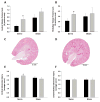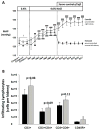Increased Perfusion Pressure Drives Renal T-Cell Infiltration in the Dahl Salt-Sensitive Rat
- PMID: 28696224
- PMCID: PMC5589123
- DOI: 10.1161/HYPERTENSIONAHA.117.09208
Increased Perfusion Pressure Drives Renal T-Cell Infiltration in the Dahl Salt-Sensitive Rat
Abstract
Renal T-cell infiltration is a key component of salt-sensitive hypertension in Dahl salt-sensitive (SS) rats. Here, we use an electronic servo-control technique to determine the contribution of renal perfusion pressure to T-cell infiltration in the SS rat kidney. An aortic balloon occluder placed around the aorta between the renal arteries was used to maintain perfusion pressure to the left kidney at control levels, ≈128 mm Hg, during 7 days of salt-induced hypertension, whereas the right kidney was exposed to increased renal perfusion pressure that averaged 157±4 mm Hg by day 7 of high-salt diet. The number of infiltrating T cells was compared between the 2 kidneys. Renal T-cell infiltration was significantly blunted in the left servo-controlled kidney compared with the right uncontrolled kidney. The number of CD3+, CD3+CD4+, and CD3+CD8+ T cells were all significantly lower in the left servo-controlled kidney. This effect was not specific to T cells because CD45R+ (B cells) and CD11b/c+ (monocytes and macrophages) cell infiltrations were all exacerbated in the hypertensive kidneys. Increased renal perfusion pressure was also associated with augmented renal injury, with increased protein casts and glomerular damage in the hypertensive kidney. Levels of norepinephrine were comparable between the 2 kidneys, suggestive of equivalent sympathetic innervation. Renal infiltration of T cells was not reversed by the return of renal perfusion pressure to control levels after 7 days of salt-sensitive hypertension. We conclude that increased pressure contributes to the initiation of renal T-cell infiltration during the progression of salt-sensitive hypertension in SS rats.
Keywords: blood pressure; diet; immune system; lymphocytes; rats.
© 2017 American Heart Association, Inc.
Conflict of interest statement
None
Figures




References
-
- Hughson MD, Gobe GC, Hoy WE, Manning RD, Douglas-Denton R, Bertram JF. Associations of glomerular number and birth weight with clinicopathological features of African Americans and whites. American Journal of Kidney Diseases. 2008;52:18–28. - PubMed
Publication types
MeSH terms
Substances
Grants and funding
LinkOut - more resources
Full Text Sources
Other Literature Sources
Medical
Research Materials

